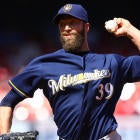Sloth would seem to be the starting pitcher's favorite sin. Starters work once every fifth game (for dwindling lengths of time), and when they're not on the mound they can be seen laughing and yakking with their pals in the dugout. Such a depiction is a misrepresentation, obviously. Starters throw and lift and run and throw some more between outings. They attend meetings and study their next opponent. They try to stave off boredom and anxiety. They're busy people but in a dull, steady, unseen way that would seem to prepare them for retirement.
Chris Capuano knows all about starting and its necessary routines. He amassed 225 starts across 12 seasons in the majors, with his last one coming in July 2015, about 10 months before his conclusive big-league appearance. Capuano has since entered retirement, a state he seems less certain about, considering he's busier now than when he was on an active roster.
Overapplication has left the "crafty lefty" label threadbare, but the tag sure fit Capuano, who graduated from Duke with an economics degree. His fastball never averaged over 90 miles per hour during his majors career, per FanGraphs, instead topping out at 89.3 mph. His studious nature inspired him to pick up a backpack after he set down his glove. He sought a place where he could gain perspective, knowledge, and skills. The journey led him to the MIT Sloan Fellows MBA program. He's expected to graduate in June.
"I always looked at education as something you should pursue your whole life," he told CBS Sports.
Capuano isn't merely learning by leafing through case studies, he's gaining firsthand experience as part of Boston Biomotion, a start-up company name-checked in Sports Illustrated by former NBA commissioner David Stern. Capuano stumbled across Biomotion's booth at last year's Sloan Analytics Conference after partaking in a panel about virtual reality in sports. There he encountered Proteus, the company's signature device that is named after the protean Greek god of the sea. Fittingly, Proteus allows for a greater range of movement and its "magnetic 3D resistance" emits a sensation similar to underwater immersion. Capuano was sold. He's since transitioned from an angel investor into a developmental strategist.
The "true genius" of the machine, per Capuano, is the integrated software that allows for comprehensive analysis using objective data -- something more standard workout equipment lacks. "Think iPhone versus the flip phone," he explained. "You exercise on the machine, the machine then produces data and insights that are automatically fed back in to inform future training sessions. You train again, and basically repeat that process indefinitely."
Capuano, who underwent two Tommy John surgeries during his career, believes Proteus can help pitchers gain intimate and actionable insights into their bodies. The machine tracks movement to a "sub-millimeter" accuracy and "measures force production, explosiveness, and consistency of movement." The device's versatility allows pitchers to replicate their deliveries in whole, ostensibly allowing them to pinpoint potential flaws in their bodies and mechanics before the blemish results in an injury.
At least one well-regarded club has signed on with Biomotion to lease a Proteus machine for two years. The copycat nature of the league, combined with its eagerness to chase any potential balm for arm injuries, dictates other teams will follow suit. Proteus' effectiveness will determine if it becomes a fixture, or, in staying true to its namesake, a relic of the past.
Capuano, for his part, seems certain to play a role in baseball's future. Though he doesn't have an official title, he remains part of the union's pension committee. Following his graduation, he expects to take on a bigger role with the Players Association, lending his perspective as a former player and team rep and as an educated and tested businessperson.
Predictably, Capuano is well-versed on baseball's current labor situation. During a 30-minute phone call, he referenced baseball's long-term well-being multiple times. For example, he said that the industry's revenue numbers (more than $10 billion) are good and growing, but that there's a sense they're masking "some potentially erosive problems." Those woes include poor marketing and teams' willingness to sit out the free-agent market until winter's end -- a development that bores fans and irritates players. "A lot of people tend to think that the union's sole concern is just increasing the players' share of the pie, and they see MLB as the ones responsible for the best interest of the game," Capuano said. "As players, we can't help but be all-in that the game is going in the right direction and that fans are passionate and engaged."
Call it Selig's Law that any and all discussions about baseball's labor situation arrive at the topic of a work stoppage. All other major American sports leagues have endured a lockout or strike since the last time baseball did. For a league that experienced eight work stoppages over a 23-year period, these two decades of labor peace have become a pride point. That doesn't, however, mean labor strife is unthinkable.
The current collective bargaining agreement runs through the 2021 season, but with animosity on the rise, it seems likely that trouble lies ahead. "Nobody wants a work stoppage. But some of the changes in club behavior that we've seen over the past four, five years -- whether it comes to free-agent signings or the way they compete during the year -- put a lot of the core issues on the table in terms of minimums, salary arbitration, and free agency," Capuano said. "There's a lot of smart people on both sides and I would hope that we can figure out a way to realign incentives and make necessary changes without it coming to that, but you never know."
For as uncertain as baseball's future looks, there is inspiration to be found in Capuano's story. The unknown doesn't have to be scary or bad -- with the right approach, it's merely an opportunity for reinvention.


















